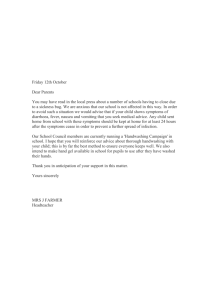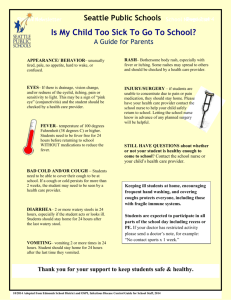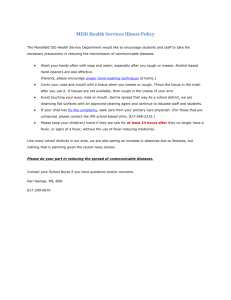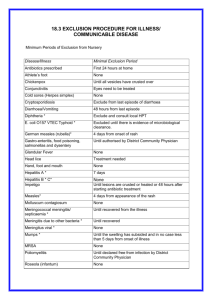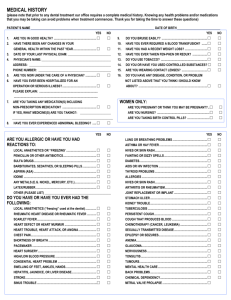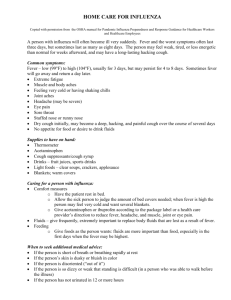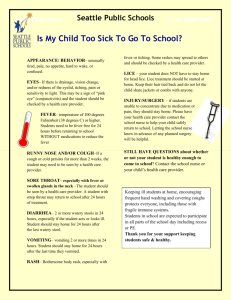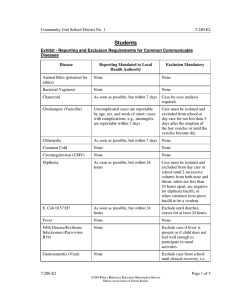Oregon Rules For Exclusion
advertisement
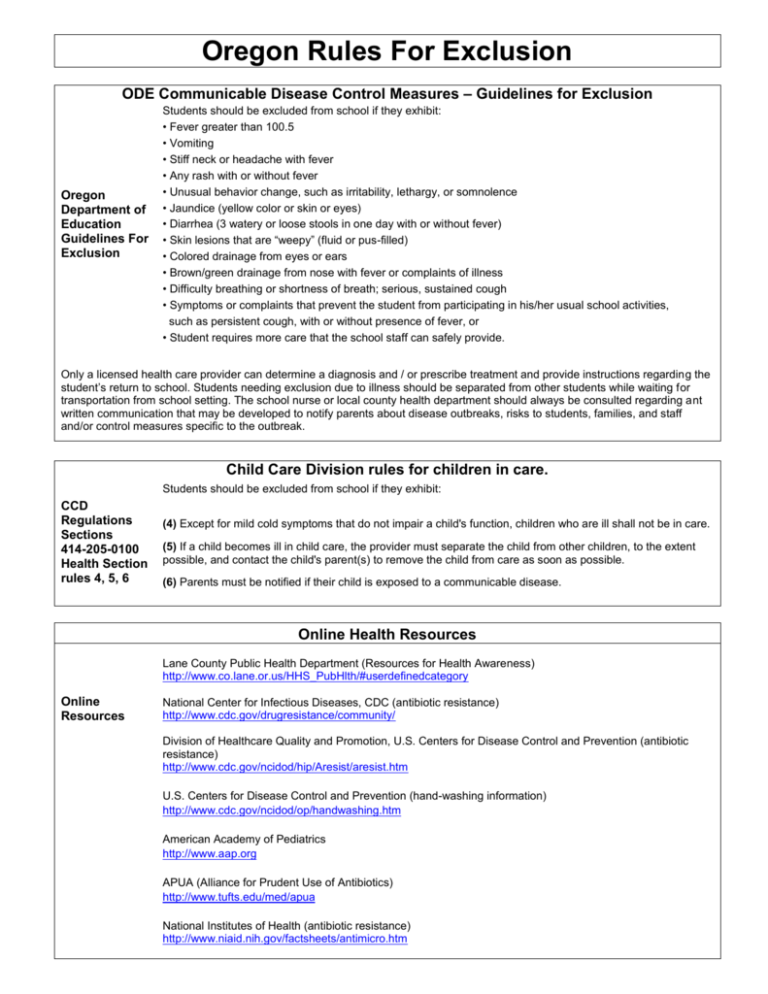
Oregon Rules For Exclusion ODE Communicable Disease Control Measures – Guidelines for Exclusion Oregon Department of Education Guidelines For Exclusion Students should be excluded from school if they exhibit: • Fever greater than 100.5 • Vomiting • Stiff neck or headache with fever • Any rash with or without fever • Unusual behavior change, such as irritability, lethargy, or somnolence • Jaundice (yellow color or skin or eyes) • Diarrhea (3 watery or loose stools in one day with or without fever) • Skin lesions that are “weepy” (fluid or pus-filled) • Colored drainage from eyes or ears • Brown/green drainage from nose with fever or complaints of illness • Difficulty breathing or shortness of breath; serious, sustained cough • Symptoms or complaints that prevent the student from participating in his/her usual school activities, such as persistent cough, with or without presence of fever, or • Student requires more care that the school staff can safely provide. Only a licensed health care provider can determine a diagnosis and / or prescribe treatment and provide instructions regarding the student’s return to school. Students needing exclusion due to illness should be separated from other students while waiting for transportation from school setting. The school nurse or local county health department should always be consulted regarding ant written communication that may be developed to notify parents about disease outbreaks, risks to students, families, and staff and/or control measures specific to the outbreak. Child Care Division rules for children in care. Students should be excluded from school if they exhibit: CCD Regulations Sections 414-205-0100 Health Section rules 4, 5, 6 (4) Except for mild cold symptoms that do not impair a child's function, children who are ill shall not be in care. (5) If a child becomes ill in child care, the provider must separate the child from other children, to the extent possible, and contact the child's parent(s) to remove the child from care as soon as possible. (6) Parents must be notified if their child is exposed to a communicable disease. Online Health Resources Lane County Public Health Department (Resources for Health Awareness) http://www.co.lane.or.us/HHS_PubHlth/#userdefinedcategory Online Resources National Center for Infectious Diseases, CDC (antibiotic resistance) http://www.cdc.gov/drugresistance/community/ Division of Healthcare Quality and Promotion, U.S. Centers for Disease Control and Prevention (antibiotic resistance) http://www.cdc.gov/ncidod/hip/Aresist/aresist.htm U.S. Centers for Disease Control and Prevention (hand-washing information) http://www.cdc.gov/ncidod/op/handwashing.htm American Academy of Pediatrics http://www.aap.org APUA (Alliance for Prudent Use of Antibiotics) http://www.tufts.edu/med/apua National Institutes of Health (antibiotic resistance) http://www.niaid.nih.gov/factsheets/antimicro.htm Criteria for Excluding Children from Child Care Condition Cough Ear Infections Colds/Nasal Congestion/ Discharge Chicken Pox Symptoms The vast majority of cough illness in children is from viruses; and coughs may linger after congestion goes away. Medical evaluation is only necessary for children with very severe cough, high persistent fever, or who appear ill. Chronic or recurrent cough may indicate asthma and should be evaluated. Generally not contagious. Exclusion not warranted unless high fever or ill appearance. Ear infections do not always need to be treated with antibiotics. Most common symptoms of viral infections. Viruses are contagious, even before symptoms appear. The color of mucus (even yellow or green) is common to viral illnesses. Neither exclusion nor antibiotics are warranted. Children with a high or persistent fever or severe nasal discharge who have not improved after 10-14 days may be evaluated for sinus infections. Exclude for five days after onset of the rash OR until all lesions have dried and crusted over, whichever is later, Prevention Handwashing, air out room daily, clean surfaces and utensils. Handwashing, air out room daily, clean surfaces and utensils. Handwashing, air out room daily, clean surfaces and utensils. (Flue vaccine for high-risk children). Immunize Conjunctivitis (pink eye) Exclude for 24 hours after treatment begins for purulent conjunctivitis (red or pink conjunctiva with white or yellow discharge) Make sure hands are clean before treating child's eye and promote good hygiene; wash hands after contact with child's eye or with discharge. Diarrhea Exclude when the stool is watery loose AND cannot be contained by diapers or controlled by toilet use. Exclude if stool contains blood or mucus, or accompanied by a fever. Handwashing, air out room daily, clean surfaces and utensils. Head Lice (Pediculosis) Exclude until morning after treatment begins. Impetigo Exclude for 24 hours after treatment begins. Mouth Sores Pertussis Rash Exclude only children who cannot control their saliva, unless the child's physician or local health department states the child is not infectious. Exclude until 5 days of appropriate antibiotic therapy has been completed. If no antibiotics are taken, exclude for 3 weeks after onset of cough. Exclude if accompanied by a fever or behavior change until a physician determines that the illness is not a communicable disease. Ring worm (Tinea) Exclude until after treatment begins. Scabies Exclude until after treatment is completed. Strep Throat Vomiting Exclude for 24 hours after treatment begins AND the child has had a normal temperature for 24 hours. Exclude if the child has vomited two or more times in the previous 24 hours, unless the vomiting is determined to be due to a non-communicable condition and the child is not in danger of dehydration. Early detection is best, avoid physical contact with infested person and his or her belongings. Always keep belongings of children separated; wash and dry all items in contact with the infected person. Handwashing, air out room daily; clean surfaces and utensils. Handwashing. Immunize; antibiotics for those in contact with infected person. Handwashing. Keep environment clean, dry, and cool. Wash and dry all washable items that were in contact with the infected skin; always keep belongings of children separate. Handwashing, air out room daily, clean surfaces and utensils. Handwashing.
